Market Growth Projections
The Global Automotive Bumper Fascia Market Industry is projected to experience substantial growth in the coming years. With a market value of 35.2 USD Billion in 2024, the industry is expected to expand significantly, reaching 52.9 USD Billion by 2035. This growth trajectory suggests a compound annual growth rate (CAGR) of 3.77% from 2025 to 2035. Such projections indicate a favorable environment for investment and innovation within the sector, as manufacturers seek to capitalize on emerging trends and consumer demands. The anticipated growth underscores the importance of strategic planning and adaptation to maintain competitiveness in this evolving market.
Growing Automotive Production
The Global Automotive Bumper Fascia Market Industry is experiencing growth driven by an increase in automotive production. In 2024, the market is projected to reach 35.2 USD Billion, reflecting the rising demand for vehicles across various regions. Countries such as China and India are leading in automotive manufacturing, contributing significantly to this growth. As manufacturers strive to meet consumer preferences for safety and aesthetics, the demand for high-quality bumper fascias is likely to rise. This trend indicates a robust market environment, with manufacturers focusing on innovative designs and materials to enhance vehicle performance and appeal.
Emerging Markets and Economic Growth
The Global Automotive Bumper Fascia Market Industry is poised for growth due to the economic development in emerging markets. Countries in Asia-Pacific and Latin America are witnessing a rise in disposable income, leading to increased vehicle ownership. This economic growth is driving demand for automotive components, including bumper fascias. As these markets expand, the industry is projected to grow at a CAGR of 3.77% from 2025 to 2035, with the market expected to reach 52.9 USD Billion by 2035. This trend highlights the potential for manufacturers to tap into new markets and cater to the evolving needs of consumers in these regions.
Technological Advancements in Materials
The Global Automotive Bumper Fascia Market Industry is benefiting from advancements in materials technology. Innovations such as lightweight composites and high-strength plastics are being integrated into bumper fascia designs, enhancing durability and performance. These materials not only improve the structural integrity of the fascias but also contribute to fuel efficiency by reducing vehicle weight. As manufacturers adopt these advanced materials, the market is likely to see a shift towards more sustainable and efficient production processes. This trend aligns with global efforts to reduce emissions and improve vehicle efficiency, positioning the industry for long-term growth.
Regulatory Standards and Safety Features
The Global Automotive Bumper Fascia Market Industry is influenced by stringent regulatory standards aimed at enhancing vehicle safety. Governments worldwide are implementing regulations that require vehicles to meet specific safety criteria, including crashworthiness and pedestrian protection. As a result, manufacturers are increasingly investing in advanced bumper fascia designs that comply with these regulations. This focus on safety not only drives innovation but also increases the demand for high-quality materials and manufacturing processes. Consequently, the market is expected to expand as manufacturers prioritize safety features in their designs, ensuring compliance with evolving regulatory frameworks.
Rising Consumer Demand for Vehicle Customization
Consumer preferences are shifting towards personalized vehicles, which is influencing the Global Automotive Bumper Fascia Market Industry. As consumers seek to differentiate their vehicles, the demand for customized bumper fascias is increasing. This trend is particularly evident in regions with a strong automotive culture, such as North America and Europe. Manufacturers are responding by offering a variety of designs and finishes, which cater to individual tastes. The customization trend not only enhances the aesthetic appeal of vehicles but also contributes to the overall market growth, as consumers are willing to invest in unique features that reflect their personal style.





















Leave a Comment